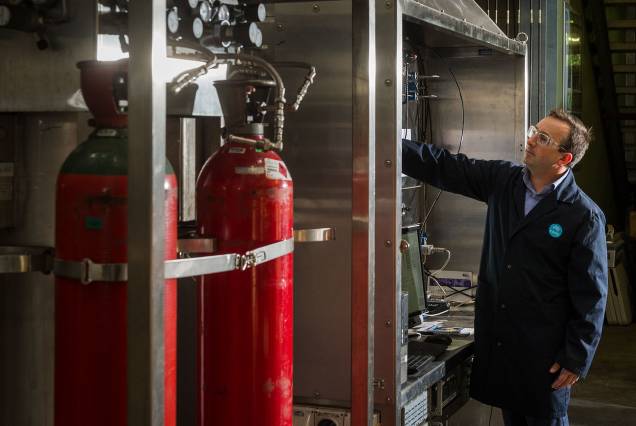
Hydrogen – The Right Gas To Export In Huge Quantities | Image : CSIRO
Technology being developed by CSIRO could see Australia becoming a major exporter of hydrogen; home brewed with the assistance of renewable energy sources such as solar power.
Solar and electrochemical technology advances are expected to make renewable hydrogen production competitive with fossil fuel-based production. While using solar power in electrolysis to extract hydrogen from water (including seawater) for use in fuel cells is well understood, transporting and storing hydrogen is a tricky and costly business, creating a significant barrier.
Perhaps not for long.
The clever folks at CSIRO are in the late stages of developing a device that will enable hydrogen to be shipped in ammonia (NH3) form using existing infrastructure and then reconverted back to hydrogen at the point of consumption. It can then be used in fuel cell vehicles, for electricity generation and industrial processes.
As well as using solar in the hydrogen process, nitrogen gas required to make the ammonia can be sourced from air using a nitrogen generator that could also be powered by renewables.
The centerpiece of the reconversion technology is a membrane reactor featuring a thin metal membrane that allows hydrogen to pass through during the ammonia decomposition process, while blocking all other gases. Apparently, the membrane is in the final stages of development and it may not be too long before it’s ready for prime time.
The membrane reactor is only one component of the system and CSIRO will also be developing all other elements of the process including the solar photovoltaics and solar thermal, water electrolysis, ammonia synthesis other aspects.
If the CSIRO is successful, Australia could become a leading exporter of hydrogen locked up in ammonia. Unlike our mad dash to export LNG, it seems we’ll be none the worse off for it – quite the opposite.
Chair of Renewable Hydrogen Brett Cooper believes the associated export industry could match the scale of the current LNG industry.
The two-year project is being supported by BOC, Hyundai, Toyota and Renewable Hydrogen Pty Ltd.. The Science and Industry Endowment Fund (SIEF) has provided $1.7 million to help fund the work, which is being matched by CSIRO.
“This is a watershed moment for energy, and we look forward to applying CSIRO innovation to enable this exciting renewably-sourced fuel and energy storage medium a smoother path to market,” said CSIRO Chief Executive Dr Larry Marshall.
According to a recent MarketsAndMarkets report, the global hydrogen generation market is expected to grow from an estimated value of USD 115.25 billion in 2017 to USD 154.74 billion by 2022.

 RSS - Posts
RSS - Posts



Hi
What do you think of the patent being applied for by Star Scientific (www.starscientific.com.au)? How would this link up with the metal membrane for extracting hydrogen?
Where can one find a cost versus benefit analysis of the total potential approach, involving export of hydrogen combined with ammonia, extraction back to hydrogen, and then use of Star Scientific’s claimed breakthrough to convert old coal-fired energy generation plants.
Note: I hold some shares in Star Scientific, although I don’t know if the company is credible, given past fantastic claims I heard about their having muon-catalyzed nuclear fusion never having materialized.
What do I think? Well, muon cold fusion does exist:
https://en.wikipedia.org/wiki/Muon-catalyzed_fusion
Apart from that I can’t say anything except that it is a long shot. The options are:
1) It won’t work
2) Works, but not be cost effective compared to solar and other clean energy sources
3) Works and is cost effective but others get there first
4) Works and is cost effective, they get there first, and has a huge payoff
So you could get lucky with your investment. Just don’t go relying on them for your retirement money.
Star Scientific has been claiming for several years now that they have found a way to make the process work cost effectively, and that they are in the “commercialization” stage. They were claiming to have found a way to bypass the “alpha-sticking” problem. All of a sudden, muon-catalyzed fusion is documented on their new website as being their “long term” objective, which means to me that they never had it working cost effectively and likely never will. So, their credibility with me is low. However, they do claim in their announcements to shareholders, which we receive, their new device for a solid-state approach to using hydrogen in coal-fired energy plants, by just replacing the boiler in these coal-fired plants.
Just by replacing the boiler? Well, that sounds easy.
Unfortunately I have to leave now and head out to Bunnings to stock up on some ten foot poles.
Ten foot poles? 🙂 No, seriously, I can send you the Members Update. If you use the follow-the-money principle, Star Scientific did just receive a 20 million AUD investment in their project, which probably means they do have that device that makes it easy to convert a coal-fired plant to one that uses hydrogen. It’s apparently a solid-state solution, and they have a patent pending. Their Member Update said that it passed CSIRO’s test with flying colours. Being in Australia, you might know how to check it out with CSIRO.
Anyways, in Canada, we only sell 8 or 12 foot poles! 🙂
Ed
How will the ammonia be made? The Haber-Bosch process is an energy hog, so if there is a new process that makes this less expensive, energy-wise, farmers around the world will be in celebration!
In Japan they are working on an improved catalyst to reduce the heat need to make ammonia while in the US they are working on reduced pressure. Either of these reduce the amount of energy required, but there’s no magic bullet and efficiency improvements are likely to be small. I don’t know what approach the CSIRO is taking.